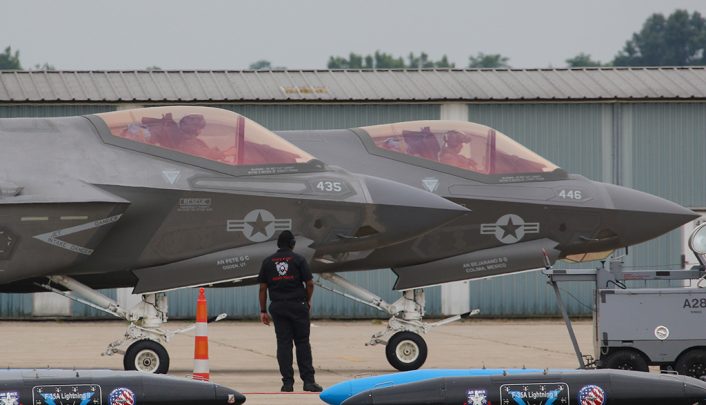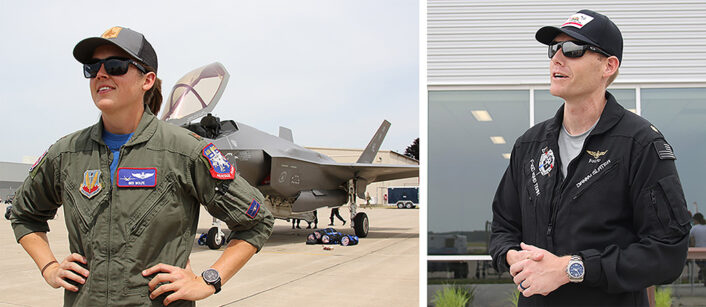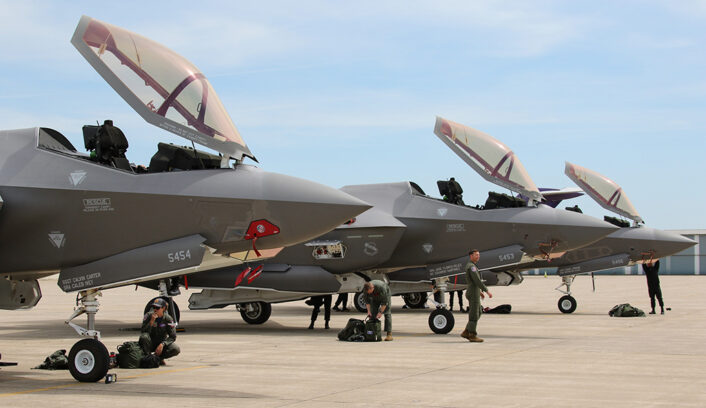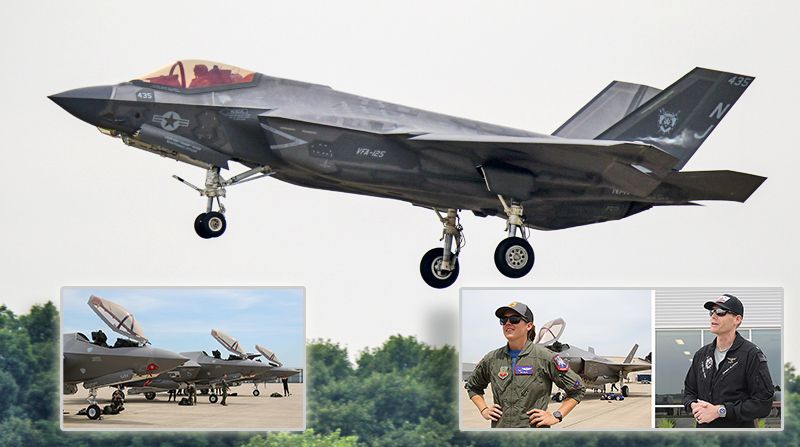Two F-35 Demo Teams Showcase and Contrast Roles and Capabilities of Joint Strike Fighter.
If you’re lucky, you get to see one or two aviation firsts in your lifetime. At the Battle Creek Field of Flight Airshow on July 2-3, 2022, aviation enthusiasts got to see two. The Field of Flight Airshow at Battle Creek Executive Airport, Kellogg Field, in Battle Creek was the first time the U.S. Navy’s F-35C Demo Team flew at a Michigan airshow.
The two Joint Strike Fighter demo teams highlighted the differences between the Navy and Air Force versions of the F-35 and how their unique capabilities and crews complement each other.

The convergence of the two demonstration teams provided a valuable insight into the progress of the overall Joint Strike Fighter program. This first-ever meeting of the F-35 demos also showcased the inter-service capabilities of the Joint Strike Fighter program.
And, it was a chance for aviation fans to see two stunning flight demonstrations despite the cancellation of Saturday’s flying due to a tragic accident that claimed the life of U.S. airshow performer Chris Darnell in the crash of the Shockwave Jet Truck.
The timing for this double-demo was good. The F-35 Joint Strike Fighter first flew 15 years ago in December, 2006. The first operational F-35s were deployed 9 years later with the U.S. Marines in July of 2015. The program became a lightning rod of criticism and fiscal concern during the first decade of testing and integration into operational service. Much of the mainstream reporting about the program was poorly informed and heavily biased as costs escalated and schedules were stretched. During this time, the general public had difficulty grasping the capabilities of the program, many of which are complex, challenge historical combat aircraft paradigms or remain classified.
But according to Senior National Security Business Correspondent Lauren Thompson of Forbes, and F-35 prime contractor Lockheed Martin, a September 2021 report said that the F-35 program, “…expects to reduce its portion of the fighter’s cost per flight hour by 40% over the next five years, which would be consistent with a similar reduction over the previous five years”.
Additionally, unit cost of the F-35 has fallen consistently over the years, although this trend in per-aircraft cost reductions is expected to level off in coming years.
In a February 19, 2021 article by Defense Analyst and Correspondent John Tirpak in Airforcemag.com, Tirpak reported that, “In the Lot 12, 13 and 14 deal, announced in October 2019, there were 478 aircraft, and Lockheed’s unit price for the F-35A model fell below $80 million apiece for the first time. The Lot 12-14 contract reduced F-35 unit prices nearly 13 percent over the previous lots, and marked the sixth successive year of unit price reductions.”
Tirpak’s article went on to quote Lockheed Martin Vice-President of Aeronautics, Gregory M. Ulmer, as saying, “We’re working to keep a cost-neutral position for the next production lots”. Ulmer and Tirpak cited the new “Tech Refresh 3”, that Tirpak writes will include, “upgraded software, improved core processor, [and] new cockpit display” as factors for a leveling-off of cost reductions in the F-35 program. Lockheed V.P. Ulmer told Tirpak that, “We’re working to keep a cost-neutral position” for the next production lots.
But even though the initially controversial F-35 Joint Strike Fighter program has enjoyed significant fiscal and operational combat successes, many pundits still have a difficult time acknowledging the success of the F-35 program, even after a decade of solid advancements.
“A decade ago was a long time ago,” USAF Major Kristin “BEO” Wolfe told TheAviationist.com in Battle Creek this weekend.
Maj. Wolfe is the Commander of the U.S. Air Force F-35A Lightning II Demonstration Team, 388th Fighter Wing, Hill Air Force Base, Utah, and the team’s lead demonstration pilot.
Maj. Wolfe went on to say, “Obviously, any program is going to have its criticisms early on and go through its different types of struggles. Especially being multi-service, international, you’ve got a lot of hands in the pot trying to design one single airplane that make it fit for everybody.”
U.S Navy F-35C instructor and demo pilot, LTCR. Daniel “Jiggle” Slater, told TheAviationist.com, “When it comes to the inter-service portion of it, it is great to have a lot of parts commonality. As far as the design goes, we think that the ‘C’ model’s got a great platform for the Navy with its big wing, and can carry tons of gas. As Navy pilots, we love that. It gives us a lot more tactical fuel before we have to go max endurance and land back on the ship. The F-35’s doing a great job for us so far.”
Slater, who has flown catapult launches from aircraft carriers in the Navy’s big-winged F-35C model, told TheAviationist.com that early criticisms about the front landing gear bobbing during catapult launched were, “Not really a big problem. They adjusted the [nose landing gear] damping a bit”.

But airshow flying is different than real-world combat. Availability and readiness of frontline, operational F-35 units in both the Navy and Air Force have also improved significantly according to pilots Slater and Wolfe. And now, Air Force, Marine and foreign F-35 operators like Israel have real-world combat experience in the aircraft.
“The squadron at Hill [AFB] was already deployed. A squadron just came back from another AOR (Area Of Responsibility). We’re full-up, ready to go, flying combat airplanes. These are combat airplanes that have been on deployment,” Maj. Wolfe said.
When asked if the media and general public still has difficulty understanding the capabilities of the F-35, Maj. Wolfe said:
“Probably. There’s stuff that you don’t see out there. Like, you barely see that we had a squadron in Spangdahlem [Air Base, Germany], or now we have a squadron in Guam. That really doesn’t make it out to the media. Nobody [in media] really knows what they’re doing out there. I can tell you they’re doing their mission that they trained to do- both in Europe and in Asia. It’s very hush-hush. Sometimes that makes people a little skeptical.”

From a historical perspective, cynicism in a joint-service, one-plane-fits-all solution for tactical air combat is well founded. Beginning in December, 1964, the General Dynamics F-111 was supposed to be a one-aircraft fit for both the Navy and Air Force. Then-Secretary of Defense Robert McNamara, who came from an automotive manufacturing background as former President of Ford Motor Company, used early spread-sheet analysis of cost effectiveness to “prove” the fiscal case for the joint-service F-111. But McNamara wasn’t a fighter pilot. He was an accountant. And that may have been a factor in the F-111’s early problems.
The F-111 program came on the heels of ongoing success with the McDonnell-Douglas F-4 Phantom II, a legendary multi-mission combat aircraft that eventually served with every U.S. air arm and the air forces and navies of countries around the world with resounding success. Two air forces, Iran and Greece, continue to use the multi-mission, multi-service F-4 Phantom II today, making it the original “Joint Strike Fighter”.
But McNamara’s F-111 one-aircraft-fits-all fiscal concept met with operational disaster. The F-111 never did make it into operational service with the U.S. Navy. The initial deployment of Air Force F-111s to Vietnam was a calamity. In March and April, 1968, three F-111s were lost in Vietnam, likely due to persistent flight control problems. Four years later in 1974, after upgrades, the F-111 returned to Vietnam where it did have considerable operational success in the later stages of the conflict. The Navy went on to develop its own aircraft with Grumman, the F-14 Tomcat, which was conceived as a fleet-defense interceptor. The F-14 did finish its operational service as a strike aircraft however, nicknamed the “Bombcat”.
But for the F-35 program, the first ever dual-appearance of two operational Joint Strike Fighter demo teams at one airshow was a watershed moment. And while, especially with the F-35 program, the capabilities aren’t about aerobatics and flight demos, just the frequency of seeing F-35s flying impressively in the airshow box has shifted public perception in some circles.
“Now we’re fully spun up doing 25 shows a year,” Major Kristin “BEO” Wolfe told TheAviationist.com. “Everywhere we go- we haven’t been too many places twice- we see people that have never seen the airplane fly. They say, ‘Wow! I did not know it could do that!’, just because they’re reading all the articles and it’s very hard to tell people it’s a very capable airplane. We can’t even show off everything in an airshow environment that we actually do tactically. It’s kind of the crowd-pleasers [at the airshows] versus the combat capabilities.”
And even though both the Navy and the Air Force F-35s continue to gather airshow fans with their expanding schedule of demos, as Maj. Wolfe says, the F-35’s real-world combat capabilities are not about airshow performances. They’re about real-world combat, something the F-35 has done very well at so far across all the services.

A previous version of this article stated that this was the first time the two teams performed at the same airshow. However, we have verified this was not the case (first occurrence in 2021, at least two in 2022).
The Aviationist thanks Mr. Bretten Bailey and the entire media team at the Battle Creek Field of Flight Airshow along with the U.S. Air Force F-35A Demo Team and the U.S. Navy F-35C Demo Team for their kind assistance and access for this report.









